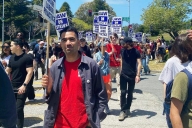You have /5 articles left.
Sign up for a free account or log in.
If there were a playbook on how to manage a university fund-raising campaign, one might think Drake University’s administrators forgot to read it when they publicly launched their $200-million campaign in September 2010.
For starters, the timing was not particularly good. Fall 2010 was a time when many questioned whether the country would ever recover from the 2008 recession, and fund-raisers across the country were worrying about reluctant donors. The university also decided to take the campaign public when it had secured less than 20 percent of its goal. In recent years, most campaigns of comparable size decided to go public when they secured between 40 percent and 60 percent of the goal.
Despite rejecting almost all of the conventional practices of a modern comprehensive fund-raising campaign, the university is in relatively good position. Four years in, through a rough economic climate, the college has raised $100 million – half its goal. With two and a half years to go, administrators said, they feel confident that they’ll make their goal.
Drake’s plan stands out in particular contrast to a group of institutions that announced campaigns in October. These high-profile institutions, which planned campaigns around the same time as Drake, rode out 2008, 2009, and 2010 in a “quiet phase” of fund-raising, putting off the public announcement of their goals and timelines. They waited for the economic climate to improve, secured large percentages of their goals before going public, and extended timelines to account for a slow economic recovery.
Drake did none of that. Administrators said the strategy, while less than ideal, was the best option given the economic climate and the university’s position. “The institution was doing extremely well,” said John P. Smith, Drake’s vice president for alumni and development. “We had momentum. The basketball team made a run in the NCAA tournament. Our president was finding his stride at the university and on a national stage. Everything felt great, with the exception of this quiet campaign.”
Even before administrators made the unconventional call to go public, they were already running a fairly unconventional organization. The university had been dormant on fund-raising since it wrapped up its previous campaign in 2002, so fund-raisers were out of practice.
A feasibility study university administrators commissioned when they were planning the campaign in 2007 said the institution did not have the depth of prospective donors for a $200-million campaign, that the fund-raising message was not fine-tuned enough, that the president was not focused enough on fund-raising, and that the vice president of alumni and development did not have enough experience. But the only way to overcome those shortcomings, consultants said, was to launch a campaign. “The only way we were going to fix the shortcomings in our operation was to put ourselves in a pressure-filled environment,” Smith said. “We knew there’d be a steep learning curve, that there would be mistakes and issues, but that was the best solution to get us to a stronger position.”
A string of meetings with donors in early 2010 made Smith think that the university needed to go public. Because of the economy, potential donors, particularly those contemplating large gifts, were hesitant to give. Smith said there just wasn’t the enthusiasm to match the university’s prospects. “We had to get to the public stage to build that infrastructure and enthusiasm,” he said. “We had a young staff and we needed this campaign to feel real in tangible ways. We needed events, and brochures. We needed letterhead.”
If people never thought the campaign was going to get off the ground, Smith said, they weren’t going to be willing to contribute. Going public would change that. When administrators decided to take the campaign public in April 2010, they had only secured $36 million in gifts. By September 2010, when the campaign formally launched, Smith and his staff had doubled the number to $74 million.
He said the pressure of going public motivated several key donors to move forward with gifts.
But even since launching, the campaign still hasn’t taken a traditional shape. Conventional wisdom in fund-raising says that campaigns should have a few large gifts by the time they go public. If Drake were conforming to that standard, it would probably have one gift of $20 million, a gift of about $10 million, and a few gifts of $5 million. At the moment, its largest gift is about $3 million.
For campaigns of Drake’s size, 94 percent of the total comes from the top 10 percent of givers, and 83 percent comes from the top 1 percent, according to the CASE survey. Drake’s distribution is more dispersed.
Smith said the campaign has not written off the possibility of the type of large gifts that campaigns often get in their early stages, but because of the economy they will likely come later in the campaign.
The unconventional campaign has had some benefits for the university. In many high-dollar campaigns, long-term pledges contribute significantly to the overall dollar figure. Drake’s intense focus on the campus’s current climate and its immediate needs have made people more willing to fork over cash. About 75 percent of the university’s gifts have been in cash or short-term pledges, which have a much more immediate effect on campus than planned gifts.
Despite the relatively shaky start, Smith said the campaign has found its stride and that it will likely meet its goal. But Smith said that doesn’t mean he wants to go through the experience again. “I’d love to start off a $300 million campaign by announcing a $100 million gift," he said.
“I would not recommend that this is the easy way to do it,” Smith said. “But it was the reality that we were faced with. It was a really interesting question."








